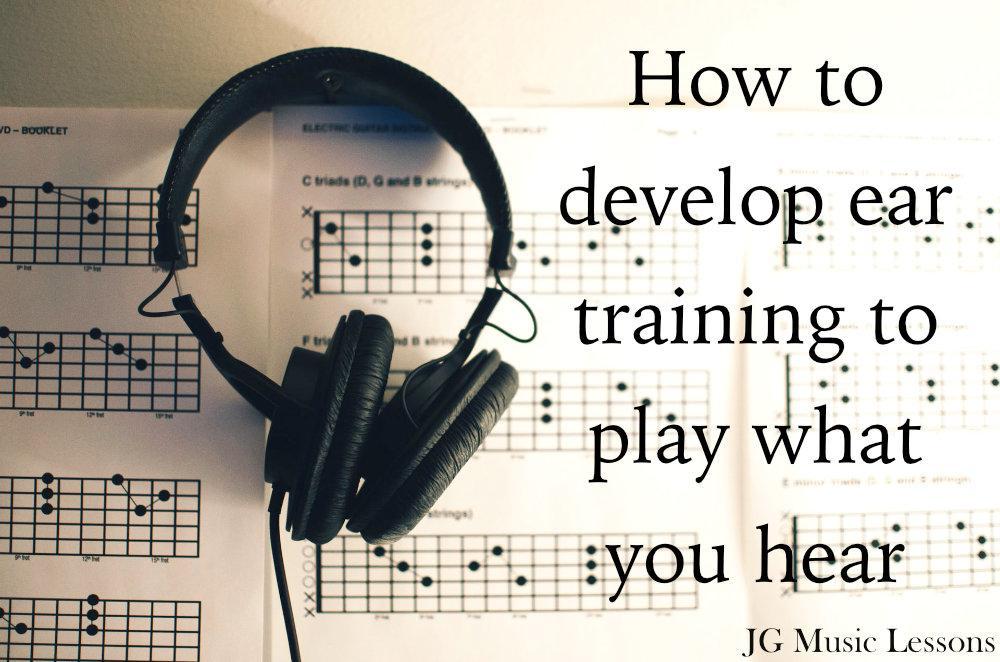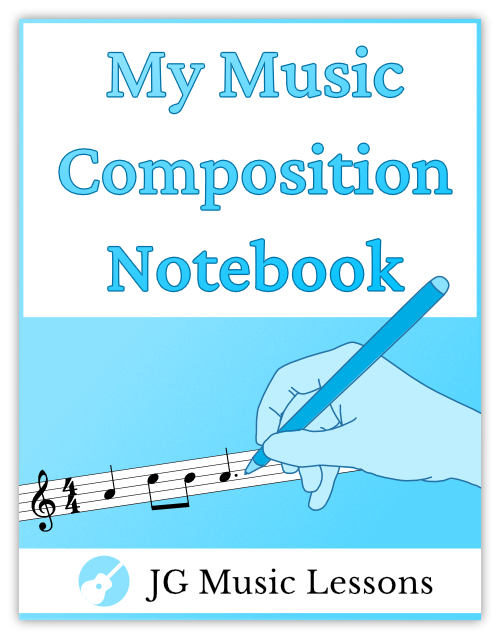Have you tried learning your favorite songs but seem to get stuck or not sure how to even approach the process to be able to play them?
In this post, we’ll cover 6 tips to develop ear training so that you can begin to play what you’re hearing. This is a very useful skill that will allow you to learn music without having to look at sheet music!
If you aren’t already familiar with this concept, this post will clarify what ear training is and give you some tools that you can start to apply!
What is ear training?
Ear training is a skill that you develop as a musician to be able to play what you hear. This includes anything from hearing the chords of a song, rhythms played, or the notes of a melody. A good way to start developing this skill is to be able to match a pitch (meaning to playback or replicate a certain note in a particular range) and then translate that sound to your instrument.
Knowing the notes on your instrument and learning music theory can help confirm what you are hearing so that you don’t have to aimlessly guess the notes you’re trying to play.
1) Learn to match a pitch
To clarify things, a pitch can be another way to say a note. It refers to the frequency or vibration that a particular note has. The way you can think about matching a pitch is similar to how an instrument tuner works.
A tuner tells you when a note pitch is higher or lower than the target note. The purpose of the tuner is to help you match the pitch of a note so that it sounds good and accurate when you play.
Similar to how a tuner works to find the right pitch, we can also learn to match a pitch when we hear it.
If you can sing it, you can play it
Before you start to do this on your instrument, a good way to start practicing this is to use your voice to match a specific note. You don’t have to be a great singer but simply try to raise or lower your voice to match a note.
If you can do this with your voice, you would apply the same concept to your instrument and move up and down until you match the target note.
The way to know that you’re matching a note is when the two sounds start to sound like one. This may take you some practice if you’ve never done this before but keep at it and you’ll start to see improvement in the time it takes to match a note.
After you learn to match a note that you hear, the next step is to do the same with a series of notes. Start by singing the notes to know that you’re hearing and matching them accurately.
You’ll then want to try to do the same thing on your instrument. Start with a very short series of notes and get them down before moving to the next part.
2) Identify intervals
An interval is the distance between two notes. Learning what these intervals between notes sound like can help you figure out what notes are being played next. These are the names of the intervals as it relates to C as the root or center.
C to Db – minor 2nd (a half step above)
C to D – Major 2nd (a whole step above)
C to Eb – minor 3rd (a whole step and a half above)
C to E – Major 3rd (2 whole steps above)
C to F – Perfect 4th (2 whole steps and a half above)
C to F# – Augmented 4th (3 whole steps above)
C to G – Perfect 5th (3 whole steps and a half above)
C to Ab- minor 6th (4 whole steps above)
C to A – Major 6th (4 whole steps and a half above)
C to Bb – minor 7th (5 whole steps above)
C to B – Major 7th (6 whole steps and a half above)
For an in depth explanation on this concept, check out how to play intervals on guitar.
Keep in mind that these intervals can also move down from a previous note. Try playing through these intervals and hear what they sound like.
By relating these intervals to songs that come to mind it can help you to remember them. It can take time to get these sounds in your ear but they can help to find the notes of a melody much quicker and accurately.
3) Finding your key signatures
When there are a series of notes you want to learn to play, there is another technique you can use to figure out those notes. If you can hear and play some of the notes, it can give you hints as to what key you are playing in.
For example, if the notes you were able to pick out by matching them on your instrument were Db, C, Bb, Ab, then you can start to assume that you’re playing in a flat key. They could be the 4th, 3rd, 2nd, and 1st degree of Ab Major.
This is where knowing your key signatures (what notes belong to a certain scale) come in handy. Finding out the key of a song gives you a guideline as to what notes to play when learning melodies, riffs or any other parts of a song.
4) Apply chord theory
If you can pick out what key you are playing in, then you also get clues for the harmony (meaning the chord progression of a song). Picking out two or more notes at a time can be difficult at first so a good way to figure out chords is to try to identify the bass notes.
The bass notes of a chord are most commonly the root notes which can define a chord. If you understand the concept of diatonic chords, the bass note can help you identify the quality of a chord such as Major, minor, diminished, etc…
Learning your diatonic chords
Diatonic chords are chords that naturally occur from each degree of a scale. For example, if we build triad chords starting on each degree of a Major scale, the 1st, 4th, and 5th degree would be Major chords. In the key of C, they would be C Major, F Major, and G Major.
The 2nd, 3rd, and 6th degree would be minor chords. In the key of C, they would be D minor, E minor, and A minor. The 7th degree would be a diminished chord or B diminished in the key of C Major. You can check out this chart on related chords.
By understanding the concept of diatonic chords, it will be easier to identify related chords when playing in any given key.
5) Writing down what you hear (aka transcribing)
If you are comfortable writing down notes in standard or tab notation, this can be a great way to write down the process of learning new material. This process is also known as transcription or transcribing music.
Transcribing will help you to visualize how the notes of melody, riff, or solo you are learning are moving up or down and give you insight into how the notes are being played. The idea is to try to extract the musical information so that you can understand, learn and also develop your own ideas.
If you haven’t tried doing this before, simply start with a small section of a melody and try writing down the notes as you hear and check them on your instrument. It will also help you to review the material you’re working on if you have it written down.
You may also want to check out these 3 simple steps to write your ideas on sheet music.
6) Finding the time signature
Another thing you can do to develop ear training is to isolate the rhythmic element of music. It can be trying to write down what you hear in a strumming pattern of a song or simply notating the rhythm of a melody line instead of the note pitches.
Identifying the time signature you are playing will help you to understand and organize a rhythm or strumming pattern you are learning. This is because a time signature is like a grid that defines how long each measure lasts.
To learn more about this, check out this simple guide to understanding time signatures.
I recommend starting with something really simple and gradually challenge yourself to more difficult rhythms. Again, you don’t always have to write things down to effectively develop ear training but it helps you to remember information later on as well as verify that you’re correctly matching a rhythm.
Wrapping up
The tools mentioned such as learning to match a pitch, identifying intervals, finding your key, apply chord theory, writing down what you hear, and learning rhythms will all help you to get better at ear training.
As you start to incorporate this into your practice, you’ll find that it is a fundamental skill that can elevate your playing to another level. I hope this information has helped you to understand the importance and benefits of ear training.
You may also want to check out this post on how to learn to play music by ear.
📘 Get the free guitar practice guide here!
All the best,
JG Music Lessons
Original photo by Kelly Sikkema on Unsplash
Start Playing Better, Faster
with Pro Membership! ✨
Get the guidance, tools, and support that keep your progress on track:
🏁 Always know what to practice next. Access the full Guitar Learning Roadmap with lessons in sequence.
🎼 Play songs with confidence. Step-by-step lessons of popular, classical pieces and other styles.
📙 Save time and frustration. Clear PDFs and ebooks that save time so you can focus on playing.
🎟️ Get rewarded for consistency. 2 free downloads every month (a $240+ yearly value).
🎁 Keep costs low while you grow. 50% off all charts, tracks, and posters — up to 75% off bundles.
🚫 Stay focused. Ad-free environment keeps you in the zone.
💬 Get help when you need it. Direct member support to keep you on track.


